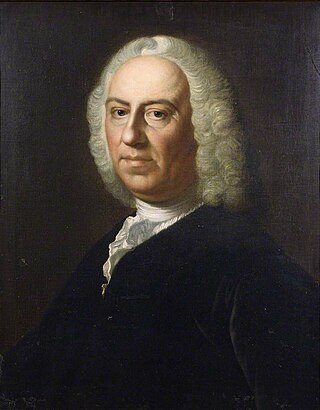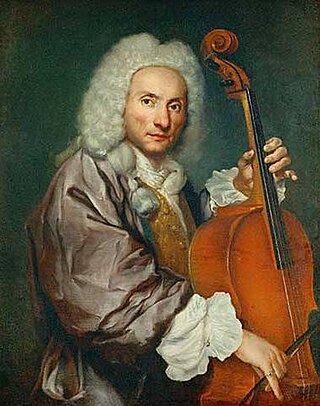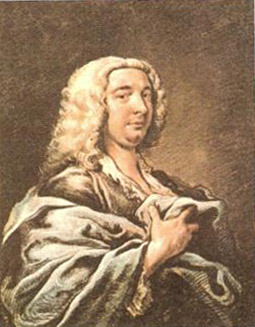Related Research Articles

Arcangelo Corelli was an Italian composer and violinist of the Baroque era. His music was key in the development of the modern genres of sonata and concerto, in establishing the preeminence of the violin, and as the first coalescing of modern tonality and functional harmony.
The concerto grosso is a form of baroque music in which the musical material is passed between a small group of soloists and full orchestra. This is in contrast to the solo concerto which features a single solo instrument with the melody line, accompanied by the orchestra.

Francesco Xaverio Geminiani was an Italian violinist, composer, and music theorist. BBC Radio 3 once described him as "now largely forgotten, but in his time considered almost a musical god, deemed to be the equal of Handel and Corelli".

Francesco Maria Veracini was an Italian composer and violinist, perhaps best known for his sets of violin sonatas. As a composer, according to Manfred Bukofzer, "His individual, if not subjective, style has no precedent in baroque music and clearly heralds the end of the entire era", while Luigi Torchi maintained that "he rescued the imperiled music of the eighteenth century", His contemporary, Charles Burney, held that "he had certainly a great share of whim and caprice, but he built his freaks on a good foundation, being an excellent contrapuntist". The asteroid 10875 Veracini was named after him.
This is a list of notable events in music that took place in the year 1734.

L'estro armonico, Op. 3, is a set of 12 concertos for string instruments by Italian composer Antonio Vivaldi, first published in Amsterdam in 1711. Vivaldi's Twelve Trio Sonatas, Op. 1, and Twelve Violin Sonatas, Op. 2, only contained sonatas, thus L'estro armonico was his first collection of concertos appearing in print. It was also the first time he chose a foreign publisher, Estienne Roger, instead of an Italian. Each concerto was printed in eight parts: four violins, two violas, cello and continuo. The continuo part was printed as a figured bass for violone and harpsichord.

Giovanni Battista Cirri was an Italian cellist and composer in the 18th century.
Pieter Hellendaal was a Dutch composer, organist and violinist.

Giovanni Battista Somis was an Italian violinist and composer of the Baroque music era.
The Camidge family supplied York Minster with organists for 103 years. Its members were:
Charles Dieupart was a French harpsichordist, violinist, and composer. Although he was known as Charles to his contemporaries according to some biographers, his real name was actually François. He was born in Paris, rue aux Ours, August 10th, 1676. His father was Nicolas Dieupart an ordinary musician to Louis XIV's Grande Ecurie. At some point, he befriended Elizabeth Wilmot of Rochester, countess of Sandwich, and Jacques Paisible who were visiting James II of England in his exile at Saint-germain-en-Laye near Paris. This is the main reason for his coming to London around 1700. A prominent member of the Drury Lane musical establishment, Dieupart was active both as composer and performer and actively participated in the musical life of the city. However, after about 1712 he earned his income mostly by teaching, and in his later years lived in poverty. He is best remembered today for a collection of six harpsichord suites which influenced Johann Sebastian Bach's English Suites.
Michael Christian Festing was an English violinist and composer. His reputation lies mostly on his work as a violin virtuoso.

The Handel organ concertos, Op. 4, HWV 289–294, are six organ concertos for chamber organ and orchestra composed by George Frideric Handel in London between 1735 and 1736 and published in 1738 by the printing company of John Walsh. Written as interludes in performances of oratorios in Covent Garden, they were the first works of their kind for this combination of instruments and served as a model for later composers.
The Avison Ensemble is one of England's leading exponents of classical music on period instruments. It is named after Charles Avison (1709–1770), the Newcastle-born composer, conductor and organist, considered ‘the most important English concerto composer of the 18th Century’. Comprising some of Europe's leading musicians and soloists, the Ensemble is directed by violinist Pavlo Beznosiuk. It varies in numbers depending on the repertoire being performed, and is typically of chamber ensemble or concerto grosso size, expanding to full chamber orchestra when needed.
NicolaFiorenza was a Neapolitan violinist and composer of the late Baroque period and a representative of the Neapolitan School.
Cecilia Maria Barthélemon was an English singer, composer, pianist, and organist. She published sonatas and other compositions and sang professionally in musicals.
Robert Valentine, also known as Roberto Valentini and Roberto Valentino, was an English composer, recorder player, oboist and violinist, who moved to Rome and became a naturalised Italian. He is noted for his large number of compositions for the recorder.
John Ravenscroft, also known as Giovanni Ravenscroft and Giovanni Rederi, was an English violinist and composer of the Baroque era, who moved to Rome. He was possibly a pupil of Arcangelo Corelli, by whom he was strongly influenced, and around the middle of the 18th century some of Ravenscroft's trio sonatas were misattributed to Corelli. He is not to be confused with the English wait John Ravenscroft.
Antonio Maria Montanari was an Italian violinist and composer of the Baroque period.
Joseph Kelway was an English organist and harpsichord player, among the most highly regarded in his day.
References
- ↑ Hawkins, John (1776/1963). A General History of the Science and Practice of Music. New York: Dover, 791
- ↑ Hawkins, John (1776 1963). A General History of the Science and Practice of Music. New York: Dover, 826
- ↑ Newspaper references are taken from Computer Register of Musical Data in London Newspapers, 1660-1800, edited by Professor Rosamund McGuinness, and held at Royal Holloway, University of London
- ↑ Dawe, Donovan (1993). Organists of the City of London 1666-1850. Padstow: Dawe, 143-44. ISBN 0-9509064-0-9
- ↑ Holman, Peter & Maunder, Richard, "The Accompaniment of Concertos in 18th-century England", Early Music 28 (4): 637-650, ISSN 0306-1078